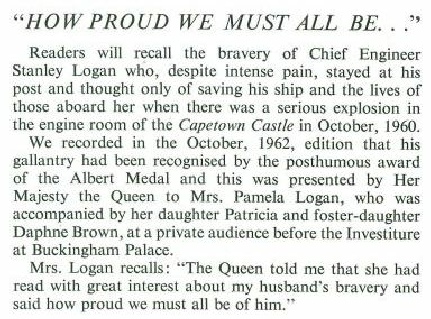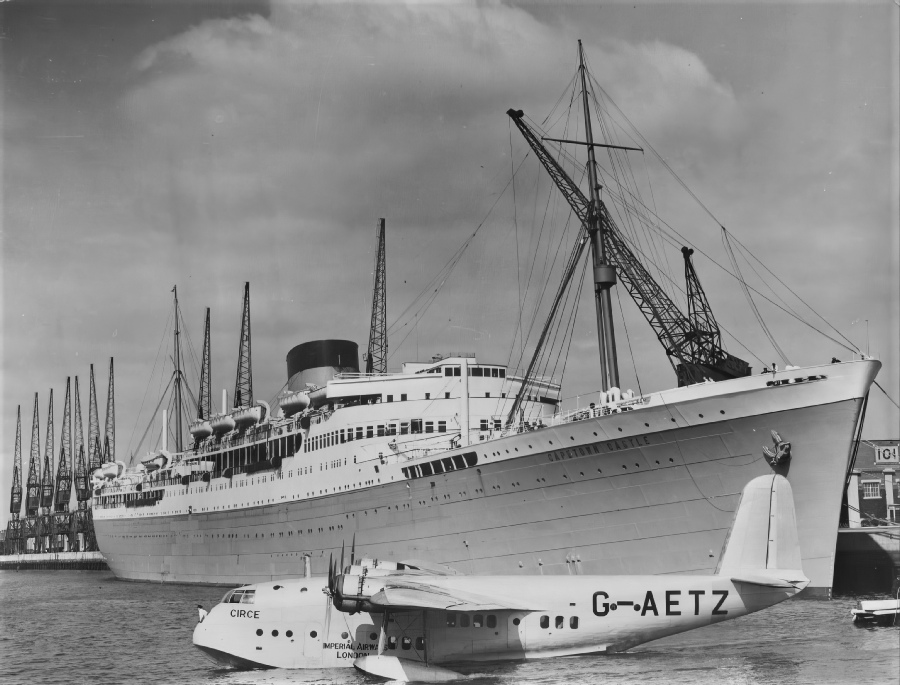|
Master |
From |
To |
|
A Barron |
4/1938 |
12/1938 |
|
Sir E H Thornton |
1/1939 |
8/1945 |
|
J C Brown |
8/1945 |
6/1948 |
|
Refit |
||
|
W D Roach |
7/1948 |
9/1949 |
|
R Wren |
9/1949 |
7/1950 |
|
J B McReynolds |
7/1950 |
8/1951 Died on board |
|
N M Lloyd Chief Officer |
8/1951 |
9/1951 |
|
H A Deller |
9/1951 |
12/1953 |
|
J H Trayner |
1/1954 |
12/1959 |
|
A G Patey |
6/1958 |
7/1958 |
|
J F Oakley |
1/1960 |
2/1960 |
|
G W Lloyd |
3/1960 |
7/1960 |
|
W S Byles |
8/1960 |
11/1961 |
|
J B James |
6/1961 |
8/1961 |
|
A T Underdown |
11/1961 |
1/1962 |
|
N M Lloyd |
1/1962 |
6/1962 |
|
W S Byles |
7/1962 |
7/1964 |
|
A J Hort |
11/1963 |
12/1963 |
|
A A Freer |
7/1964 |
8/1964 |
|
H L Holland |
8/1964 |
1/1966 |
|
R M Wright |
1/1966 |
2/1966 |
|
D W Sowden |
3/1966 |
5/1967 |
|
G E Matthews |
5/1966 |
7/1966 |
|
R H Pape |
6/1967 |
9/1967 |

|
Vessel |
Built |
Tonnage |
Official No |
Ship Builder |
Engine Builder |
Engine Type |
HP |
Screws |
Speed |
|
Capetown Castle |
1938 |
27000 |
166402 |
Harland & Wolff Belfast |
2 x Motor 10 Cyl Burmeister & Wain |
4650 BHP 28000 SHP |
2 |
20 |
|






















|
Port |
Arrived |
Sailed |
Comments |
|
Clyde |
|
12-Jan |
|
|
Gibraltar |
18-Jan |
|
|
|
Freetown |
26-Jan |
29-Jan |
|
|
Cape Town |
09-Feb |
12-Feb |
|
|
Suez |
03-Mar |
18-Mar |
|
|
Bombay |
26-Mar |
02-Apr |
|
|
Cape Town |
14-Apr |
22-Apr |
Voyage repairs |
|
Clyde |
11-May |
03-Jun |
Voyage repairs DEMS and DG repairs |
|
Freetown |
16-Jun |
20-Jun |
|
|
Cape Town |
01-Jul |
05-Jul |
|
|
Bombay |
22-Jul |
27-Jul |
|
|
Colombo |
30-Jul |
01-Aug |
|
|
Singapore |
05-Aug |
12-Aug |
Voyage repairs Drydocked |
|
Sydney |
21-Aug |
22-Aug |
|
|
Aukland |
25-Aug |
05-Sep |
|
|
Balboa |
21-Sep |
|
|
|
Cristobal |
|
23-Sep |
|
|
Bermuda |
27-Sep |
27-Sep |
|
|
Halifax |
29-Sep |
09-Oct |
|
|
Iceland |
13-Oct |
13-Oct |
|
|
Liverpool |
17-Oct |
12-Nov |
Voyage repairs |
|
Freetown |
25-Nov |
28-Nov |
|
|
Durban |
18-Dec |
24-Dec |
|
Port |
Arrived |
Sailed |
Comments |
|
Bombay |
06-Jan |
17-Jan |
|
|
Colombo |
20-Jan |
22-Jan |
|
|
Fremantle |
30-Jan |
30-Jan |
|
|
Sydney |
04-Feb |
07-Feb |
|
|
Aukland |
10-Feb |
22-Feb |
|
|
Balboa |
10-Mar |
|
|
|
Cristobal |
|
12-Mar |
|
|
Halifax |
18-Mar |
21-Mar |
|
|
Liverpool |
28-Mar |
15-Apr |
Voyage repairs Fitting DEMS |
|
Freetown |
28-Apr |
03-May |
|
|
Durban |
18-May |
23-May |
|
|
Bombay |
07-Jun |
16-Jun |
|
|
Fremantle |
27-Jun |
|
|
|
Aukland |
06-Jul |
15-Jul |
|
|
Balboa |
30-Jul |
|
|
|
Cristobal |
|
01-Aug |
|
|
Halifax |
07-Aug |
09-Aug |
|
|
Liverpool |
17-Aug |
30-Sep |
Voyage & engine repairs Drydocked Fitting DEMS |
|
Belfast |
30-Sep |
04-Oct |
|
|
Freetown |
16-Oct |
20-Oct |
|
|
Durban |
05-Nov |
09-Nov |
|
|
Bombay |
24-Nov |
29-Nov |
|
|
Cape Town |
11-Dec |
15-Dec |
|
|
Halifax |
31-Dec |
|
|
Port |
Arrived |
Sailed |
Comments |
|
Halifax |
|
07-Jan |
|
|
Liverpool |
14-Jan |
23-Feb |
Voyage, main engine and bottom covers repairs Drydocked |
|
Clyde |
24-Feb |
24-Feb |
|
|
Freetown |
09-Mar |
11-Mar |
|
|
Durban |
26-Mar |
29-Mar |
|
|
Aden |
09-Apr |
10-Apr |
|
|
Suez |
14-Apr |
16-Apr |
|
|
Aden |
20-Apr |
21-Apr |
|
|
Bombay |
26-Apr |
29-Apr |
|
|
Durban |
10-May |
13-May |
|
|
Cape Town |
15-May |
18-May |
|
|
Saldanha Bay |
18-May |
20-May |
|
|
Punta Arenas |
30-May |
31-May |
|
|
Balboa |
09-Jun |
|
|
|
Cristobal |
|
10-Jun |
|
|
New York |
16-Jun |
29-Jun |
Voyage repairs Drydocked |
|
Liverpool |
08-Jul |
13-Aug |
Voyage repairs |
|
Clyde |
14-Aug |
15-Aug |
|
|
New York |
23-Aug |
05-Sep |
Voyage repairs |
|
Liverpool |
15-Sep |
01-Oct |
Voyage repairs |
|
New York |
09-Oct |
21-Oct |
|
|
Liverpool |
02-Nov |
19-Nov |
Voyage repairs Fumigated |
|
New York |
29-Nov |
05-Dec |
|
|
Liverpool |
15-Dec |
28-Dec |
Voyage repairs Fumigated |
Port |
Arrived |
Sailed |
Comments |
|
New York |
05-Jan |
18-Jan |
|
|
Liverpool |
29-Jan |
11-Feb |
Voyage repairs |
|
Belfast |
11-Feb |
18-Feb |
|
|
Clyde |
18-Feb |
22-Feb |
|
|
Algiers |
01-Mar |
07-Mar |
|
|
Liverpool |
16-Mar |
29-Mar |
Voyage repairs |
|
Naples |
09-Apr |
11-Apr |
|
|
Liverpool |
22-Apr |
03-May |
Voyage repairs |
|
Oran |
13-May |
21-May |
|
|
Liverpool |
30-May |
15-Jun |
Voyage repairs Drydocked |
|
Greenock |
15-Jun |
18-Jul |
|
|
Port Said |
01-Aug |
07-Aug |
|
|
Taranto |
12-Aug |
12-Aug |
|
|
Port Said |
15-Aug |
19-Aug |
|
|
Taranto |
23-Aug |
24-Aug |
|
|
Port Said |
28-Aug |
10-Sep |
|
|
Taranto |
15-Sep |
16-Sep |
|
|
Port Said |
20-Sep |
25-Sep |
|
|
Naples |
29-Sep |
13-Oct |
|
|
Liverpool |
21-Oct |
09-Nov |
Voyage repairs |
|
Port Said |
20-Nov |
24-Nov |
|
|
Taranto |
28-Nov |
29-Nov |
|
|
Port Said |
03-Dec |
08-Dec |
|
|
Taranto |
12-Dec |
13-Dec |
|
|
Port Said |
16-Dec |
26-Dec |
|
Port |
Arrived |
Sailed |
Comments |
|
Liverpool |
06-Jan |
28-Jan |
Voyage repairs Fumigated |
|
Port Said |
08-Feb |
09-Feb |
|
|
Suez |
09-Feb |
14-Feb |
|
|
Bombay |
23-Feb |
01-Mar |
|
|
Suez |
08-Mar |
12-Mar |
|
|
Port Said |
12-Mar |
20-Mar |
|
|
Liverpool |
30-Mar |
17-Apr |
Voyage repairs |
|
Port Said |
28-Apr |
29-Apr |
|
|
Suez |
29-Apr |
29-Apr |
|
|
Bombay |
06-May |
18-May |
Minor repairs |
|
Suez |
25-May |
25-May |
|
|
Port Said |
26-May |
29-May |
|
|
Gibraltar |
04-Jun |
04-Jun |
|
|
Southampton |
08-Jun |
05-Jul |
Voyage repairs Drydocked - drew tail shafts |
|
Port Said |
13-Jul |
13-Jul |
|
|
Suez |
14-Jul |
14-Jul |
|
|
Bombay |
21-Jul |
28-Jul |
|
|
Suez |
04-Aug |
04-Aug |
|
|
Port Said |
05-Aug |
05-Aug |
|
|
Greenock |
13-Aug |
02-Sep |
Voyage and engine repairs Fumigated |
|
Taranto |
08-Sep |
10-Sep |
|
|
Port Said |
12-Sep |
14-Sep |
|
|
Suez |
14-Sep |
14-Sep |
|
|
Kilindini |
21-Sep |
23-Sep |
|
|
Durban |
27-Sep |
04-Oct |
Voyage repairs |
|
Kilinidini |
08-Oct |
09-Oct |
|
|
Suez |
16-Oct |
18-Oct |
|
|
Durban |
01-Nov |
06-Nov |
|
|
Kilinidini |
10-Nov |
11-Nov |
|
|
Suez |
18-Nov |
18-Nov |
|
|
Port Said |
19-Nov |
20-Nov |
|
|
Southampton |
27-Nov |
29-Nov |
Voyage and engine repairs Fumigated |
Port |
Arrived |
Sailed |
Comments |
|
Port Said |
06-Jan |
06-Jan |
|
|
Aden |
10-Jan |
10-Jan |
|
|
Bombay |
14-Jan |
20-Jan |
|
|
Suez |
27-Jan |
27-Jan |
|
|
Port Said |
28-Jan |
29-Jan |
|
|
Southampton |
05-Feb |
22-Feb |
Voyage repairs Drydocked - repairs to propeller packing |
|
Malta |
28-Feb |
28-Feb |
|
|
Port Said |
05-Mar |
05-Mar |
|
|
Aden |
09-Mar |
09-Mar |
|
|
Bombay |
12-Mar |
17-Mar |
|
|
Colombo |
19-Mar |
19-Mar |
|
|
Singapore |
23-Mar |
23-Mar |
|
|
Suez |
08-Apr |
09-Apr |
|
|
Port Said |
09-Apr |
09-Apr |
|
|
Southampton |
16-Apr |
17-May |
Voyage repairs |
|
Naples |
22-May |
22-May |
|
|
Port Said |
25-May |
26-May |
|
|
Bombay |
03-Jun |
09-Jun |
|
|
Suez |
16-Jun |
16-Jun |
|
|
Port Said |
17-Jun |
17-Jun |
|
|
Naples |
19-Jun |
19-Jun |
|
|
Southampton |
24-Jun |
|
|














 Capetown Castle Memorial
Capetown Castle Memorial









 Crew List
Crew List Crew List Crew List Crew List
Crew List Crew List Crew List















